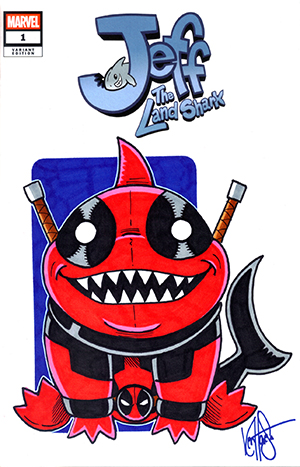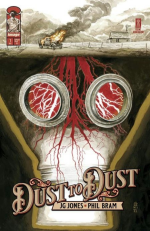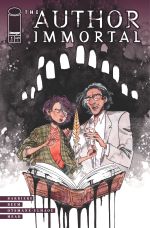J.G. JONES & PHIL BRAM
 SEND THIS TO A FRIEND! SEND THIS TO A FRIEND!
DF Interview: J.G. Jones & Phil Bram relate the hunt for a serial killer at the height of the dust-choked Great Depression in ‘Dust to Dust’ By Byron Brewer In the darkest days of the Great Depression, death stalks the Dust Bowl. As towering dust storms blast the parched Oklahoma panhandle, farmers try to flee the failing town of New Hope, but no one gets far. Battling his own demons, Sheriff Meadows teams up with Sarah, a traveling photojournalist, in a desperate fight to stop a serial killer on the loose – the Death that rides the Dusters. From illustrator/writer J.G. Jones (Wanted) and his co-writer Phil Bram comes an unforgettable yarn of desperation, murder and resilience in this beautifully hand-painted story of Americana in the primal grip of brutality. It was my true honor to discuss this coming miniseries with them both. Byron Brewer: J.G. and Phil, what a wonderful period in American history in which to play out the hunt for a serial killer: the darkest days of the Great Depression in the heart of the Dust Bowl. Man, I cannot even imagine … although my grandparents and others lived it and were forever changed by it. What was the inspiration for the crime story portion of Dust to Dust, and why the selection of this fantastic canvas for a murder hunt? J.G. Jones: Your question is pretty much the Cliff Notes for my thoughts when we began working on Dust To Dust. There are a number of different pieces that brought me to this era and place. My fascination was probably first stoked when, as a kid, I would hear stories from my grandparents about living through the era of the Great Depression. I grew up with a love of reading history, and the Dust Bowl era in Oklahoma has always fascinated me. When I was still living in and around NYC, I met my friend, Phil Bram, who was a writer and artist who also grew up in Oklahoma, so he was already well versed with the landscape and history of the area. One day we were talking about the books and music from the Dust Bowl. We both thought, man, those were some hard times, with everyone busted out and desperate to leave a dying land. “How could that have been any worse?” That sparked the idea that eventually became our tale. Phil Bram: The story of the Dust Bowl only gets more and more topical for me. I can’t think of a clearer example in American history where short-sighted greed and wishful, ignorant thinking just completely eclipses common sense. Everyone that knew that land knew better than to plow it up like that. But just like today, we see how greed often works… for a while. The liars just keep on lying… until the chickens come home to roost. It was all just a massive real estate swindle really. But there was also this incredible geopolitical wild card involved in the fact that World War I began and Russia was no longer able to get its wheat out just as all that newly-plowed land got this rare fluke of gentle weather with plenty of rain. The crops boomed and everyone doubled down and that wheat supply ended up playing a crucial role in our winning of the war. So what do you do with that? Maybe we wouldn’t have won the war if they hadn't done it? But our story takes place years later in the ghostly, hellish aftermath of those decisions where mostly people of deep religious convictions of God’s will and way remained, along with others who simply had no place left to go. There were such bizarre natural phenomena involved that make the whole thing so wonderfully surreal and otherworldly. All the strange stuff about the static electricity really blew my mind. Nature had been turned upside down. So much had been piled upon these poor people for so long. And so when J.G. said those magic words: “Now throw in a serial killer”, I was absolutely in! Byron: What research did you do for your absolutely spectacular depiction of this desperate and depressing era? Such things are endlessly fascinating to me. J.G. Jones: We both did a lot of reading and research to bring the era to life. We finished the bones of the story years ago, but I had to put it aside for a number of years do to work commitments and life intervening. The time never seemed right, and we went on with our separate lives, but we never dropped the project, and probably rewrote it a dozen times over the years. Phil Bram: Many excellent documentaries have now been made since J.G. and I dove into this thing. Ken Burns even did one. Anyone interested in our story should really do themselves a favor and check ‘em out. But we both began this journey by reading The Worst Hard Time by Timothy Egan. I think J.G. handed me his copy the first time I ever met him. It was our bible for this thing. Not to give anything away, but we also did a lot of research on aquifers and drilling technology at the time, as well as cloud seeding and things like that. As I mentioned in your first question, WW1 played a major role in this thing. And it’s absolutely striking how similar the landscape of those buried farms and equipment and fences and dead cattle etc. mirrors the visuals of the horrific fighting in the trenches. J.G. pulled off this two-page dream sequence in one of the issues that is simply astonishing! I talked him into giving me the original to frame and put on my wall. Byron: Talk about the investment of your time and imagination in the wondrous window given the story through the hand-painted depiction of America amid the Great Depression. Were there any set pieces in this 8-issue limited series crime drama that were especially difficult for you? J.G. Jones: I would say the only difficulty was finding the right format and publisher for Dust. When I finally found the right people to work with (Rick Remender’s Giant Generator imprint at Image), I just didn’t want to cheat myself. I wanted to do the best visual work of my career for a story with my name on it. I refused to half-ass it, so I did a ton of visual research to bring the era to life, to make sure even the tiny details ring true. Phil Bram: I’m a total outsider to the comic world. Embarrassingly, I never read a single comic growing up. I just wasn’t exposed to them at all. And I never read much of anything really until I left Oklahoma and began traveling for work while living mostly in NYC. But that’s when I began reading and devouring writers at a feverish pace which included some of the underground comic stuff like Crumb and Harvey Pekar, as well as, of course, Muas, and Joe Sacco’s Palestine. J.G. really had to guide me along the way on how to write into the format for him to draw. And I am forever grateful to him for trusting me to do it justice. Byron: Introduce readers to Sheriff Meadows. If it is possible, what can you tell us about the demons the Oklahoman battles within? J.G. Jones: Sheriff Meadows is basically a decent guy who has been scarred by a hard life. He signed up and went off to fight in France in WW1. He has a great love for the idea of the Great Plains, if not the current actuality of the place. He has since lost his marriage and also had some major failures on the job. He has since turned to the overindulging in bootleg whiskey to manage the damage. Phil Bram: Ah, Sheriff Lawton Meadows! Haha! I am just so pleased with him as a character. He got smashed into form almost instantaneously like a Transformer or something. I don’t even remember thinking his name up at all; it was like he had already been there in my mind all along. My father’s best friend was Larry Meadows who’s family actually got their land during the land rush of 1889. And then Lawton was a city nearby with an artillery Army base called Ft. Sill. So he’s quite a tribute character to my own childhood. Meadows was brought up on a cattle ranch and went off to serve his country. He’s a salt of the earth type of guy that’s been chewed up and spit out by life. His demons are thirsty but he’s always held a strong moral compass. And I must make it known here that it was J.G.’s idea to draw me as Meadows. I’m not quite THAT self indulgent. Haha! Byron: Who is Sarah? What is her relationship with Meadows in Dust to Dust? Can you reveal any of Sarah’s backstory here, other than she is a photojournalist… not the career one would expect to find a woman holding at this point in time. But then again, any paying job existing then was like true gold. J.G. Jones: Sarah’s character was definitely inspired by the likes of Dorothea Lange, Walker Evans, and other photographers and writers who documented the Depression for the FSA and WPA. She’s basically traveling around and witnessing the hard lives of American families trying to scrape an existence out of the bare earth. Phil Bram: Sarah’s our Dorothea Lange character: an adventurous, tough woman from New York, ready to take on anything in order to get to the truth and help the common people of the world. She’s driven but she now finds herself taken aback by her feelings for this brooding Sheriff Meadows. Byron: Without spoilers, what if anything can you tell us about the particular serial killer that has dropped onto your canvas (“The Death that rides the Dusters”), destroying the lives of farmers and other residents of New Hope, OK, as Nature brutalizes their minds and souls? J.G. Jones: I don’t want to step on my own toes here, but what you need to know is the desperation of the local farmers. Now, with this new threat, anyone who tries to flee New Hope does not get far. The massive dust storms are both perfect cover and cover up for anyone brazen enough to end their hopes and their lives. Byron: J.G., what other projects coming from you, inside or outside comics, can you tell readers about? J.G. Jones: I’m hoping that Dust To Dust will open the way for a few new projects that I want to do. I may even revive a little project that began all the way back at the beginning of my career. That may be my next focus. We’ll see. Phil Bram: I’m currently writing and compiling a collection of short stories. I hope it’s in the cards for me to be able to see it through. Dynamic Forces would like to thank J.G. Jones & Phil Bram for taking time out of their busy schedules to answer our questions. Dust to Dust #1 from Image Comics and its Giant Generator imprint is slated to be on sale December 26!
NEW! 1. 09/23/2025 - FRANK BARBIERE2. 09/16/2025 - RODNEY BARNES 3. 09/10/2025 - ZACK KAPLAN 4. 08/26/2025 - JOE PRUETT 5. 08/20/2025 - CHRISTIAN WARD Show All |







